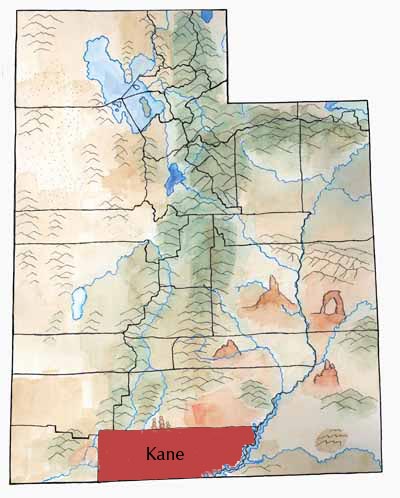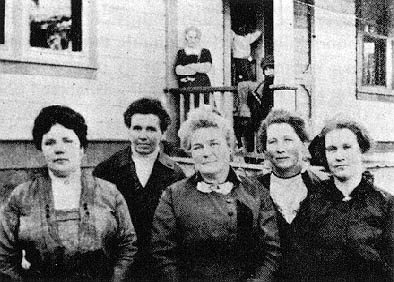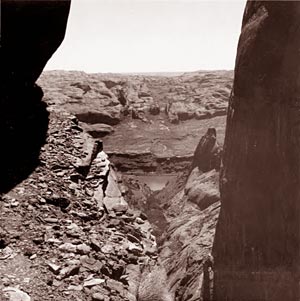The high desert landscape of Kane County belongs to the Colorado Plateau geographical province. In Kane County you can find towering sandstone cliffs, deep canyons, plateaus, mountains, and lots of sand.

The lush “Glen Canyon”—named by John Wesley Powell—once formed the eastern border; now the reservoir waters of Lake Powell cover the canyon.
Most of the county’s rivers and creeks drain into the Colorado River.
First Peoples
Paleoindian and Archaic people lived on this land thousands of years ago. These people hunted animals like deer in the uplands and desert sheep and rabbits in the desert. They learned how to gather and use a variety of desert plants. Later, the Ancestral Pueblo culture developed as people learned to farm corn, beans, and squash.

Ruins and other evidence of these ancient people dot Kane County – archaeologists have recorded hundreds of sites. Glen Canyon (Lake Powell) had many sites that are now covered by water. Before Glen Canyon Dam was completed, archaeology teams studied these sites.
The hunting-gathering Paiutes replaced the Ancestral Puebloan people in this region, who still live in the area today.
Settlers
Jacob Hamblin and other Mormons first dug a few little dugouts in the area in 1858. More settlers trickled in. Cattle owners began running cattle in the region and settlers founded more towns.
But the Black Hawk War interrupted the settlers’ hopes. In 1866, killings and raids by some American Indians—mostly Navajos—forced them to abandon their new farms. Friendly Paiutes cared for the crops after they left. When the settlers began to return later, Paiutes and Mormons worked together to grow crops and develop farmland.
In the meantime, Jacob Hamblin worked hard to establish peace between the Navajos, Hopis, Paiutes, and settlers.

Settlers didn’t start to return seriously until 1870, and when they did they tried to make Kanab a beautiful and prosperous community.
The United Order
In March 1874 Brigham Young encouraged the formation of a United Order at Orderville. Under the United Order, the people would share their possessions and work together as a community, instead of each family just looking after themselves.
Although many towns, including Kanab, organized “United Orders,” the people in Orderville lived communally more earnestly than most. They had great success and were happy for several years, but eventually, for many reasons, they gave up their experiment in communal living.
Economy
During the 19th and early 20th centuries, most of the county’s residents got their living by farming and ranching. But a new industry came to town in 1922 when Fox Film Corporation filmed Deadwood Coach with Tom Mix in Utah. The Parry brothers of Kanab led a crusade to attract more films. They developed lodging, food, and other services for film crews, and by the 1930s Kanab was called Little Hollywood because so many movies were made there.
In the 1920s and 1930s Kanab also became a tourist center for visitors to Bryce Canyon, Zion, and Grand Canyon National Parks.

During the construction of Glen Canyon Dam near Page, Arizona, which began in 1956, Kanab’s population doubled and the economy boomed. Although the population dropped after crews finished the dam, Lake Powell, one of Utah’s major recreational sites, brought in new service industries connected with boating and fishing, especially the Bullfrog Basin Marina in the extreme northeast corner of the county.
Many locals and developers have eyed the enormous coal reserves in the Kaiparowits Plateau and Alton fields as the county’s economic future, but concerns over economic viability and impacts to the region’s desert, fragile environment have so far prevented large-scale mining plans from moving forward.
Did You Know?
| At Hole-in-the-Rock, Euro-American settlers built a road down a steep cliff on their way to the Colorado River and San Juan County. |
| Kanab had the first all-woman mayor and city council in Utah. |
| The famous painter Maynard Dixon lived in Mt. Carmel. |
| So many movies were made in Kane County in the 1950s that Kanab was known as Little Hollywood. |
Fast Facts
Area: 3,904 Square Miles
County Seat: Kanab
Where it Got its Name: Colonel Thomas L. Kane, an influential supporter of members of the Church of Jesus Christ of Latter-day Saints
Main Cities and Towns: Kanab, Orderville, Glendale
Economy: Tourism, Services
Keep Exploring!
Return to the County’s home page here.
Return to the I Love Utah History home page here.